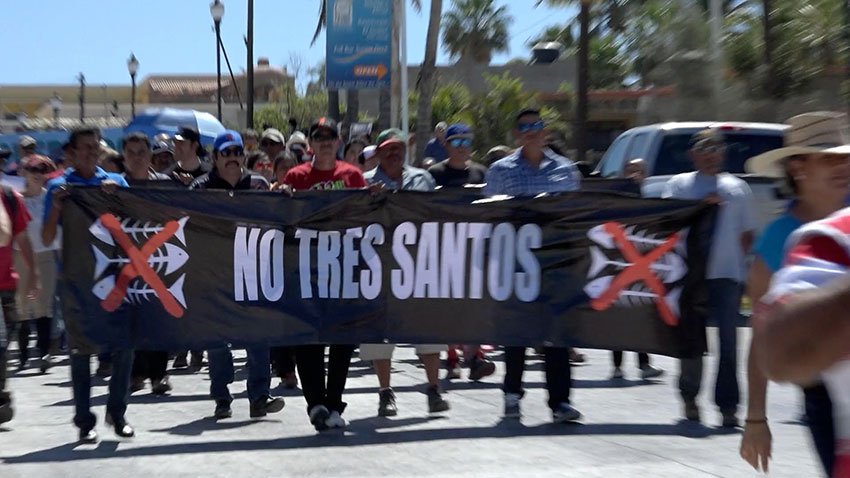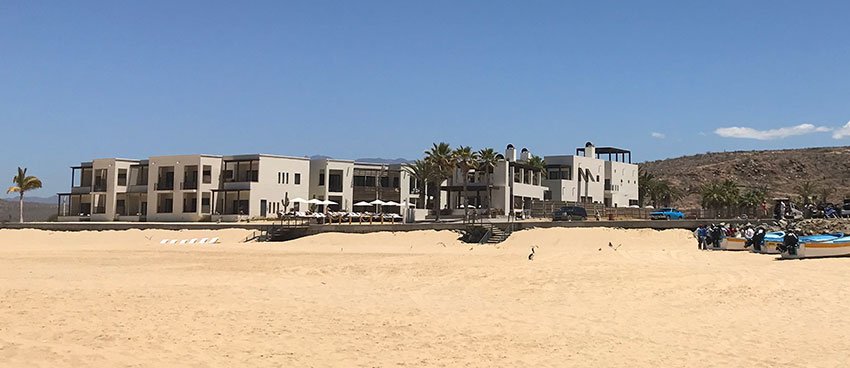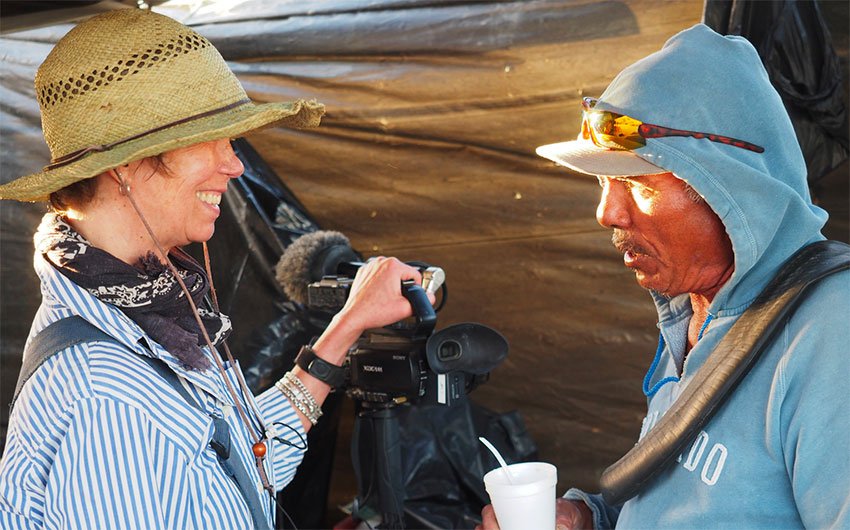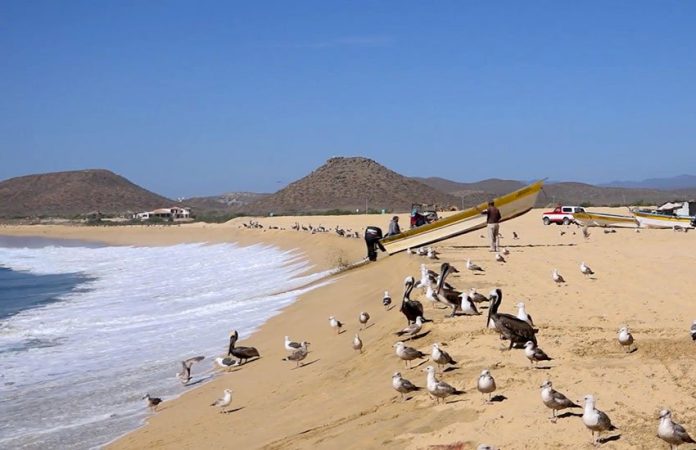In January 2015, an allegedly illegal mega development known as Tres Santos broke ground south of Todos Santos, a popular beach town on Baja California Sur’s west coast.
The plan was to build 4,400 luxury homes, a beachfront hotel, restaurants and other businesses on a fishing beach and one of the only swimmable spots in a region beloved by surfers for its powerful waves.
Opponents to the project included local fisherman who feared the development would erode their beach, and Todos Santos residents who worried the sharp population increase would deplete an already stressed natural aquifer on the arid peninsula, among other social and environmental concerns.
After nearly three years of protests and lawsuits aimed at proving the land rightfully belonged to the fishermen, most of the Tres Santos development came to a halt.
The story of the Tres Santos battle can now be seen on film.

The bilingual documentary Patrimonio by American filmmakers Lisa F. Jackson and Sarah Teale tells how fishermen and other residents fought off Tres Santos, a project spearheaded by development groups in the United States and Mexico.
Having made the rounds at film festivals around the world and winning a number of special selection awards, it is now available on iTunes Movies.
“We went down to the beach to get some fish and saw all these surveillance stakes and heard there was a big development going in there and that the fishermen were totally cool with it. So we decided to ask the fishermen and they were not cool with it,” Jackson said.
“They were terrified. They were feeling pressure on their space, they were getting notices of petty violations, and they were feeling the hot breath down their necks so they really were the first ones to feel the impact and the first ones to ask the developers where their permits were and point out they were wrecking the dunes, tearing up protected mangroves and filling in an arroyo.”
Jackson was sued by Tres Santos for her involvement on behalf of the fishermen, and the fishermen’s counsel, La Paz lawyer John Moreno, was jailed for three months.
Patrimonio alleges that Baja California Sur Governor Carlos Mendoza Davis was paid off to allow the construction to take place and Jackson said the state’s attorney general had probably been paid off as well in order to bring the false claims against Moreno.

The film focuses on what activists say was the greed of the United States and Mexican developers and the incapacity of the Baja California Sur justice system.
Tres Santos was the brainchild of the Colorado-based real estate developer Black Creek and its Mexican subsidiary, MIRA. Only three parts of the projected mega development were built: Hotel San Cristóbal on Punta Lobos beach, Jazamango restaurant and the Todos Santos Colorado State University campus.
“The only thing that stopped the development was at the federal level,” Jackson said. “A ruling that the fishermen’s concession was inviolate, federal judges ruling that John Moreno had a right to post bail, federal judges ruling that fishermen had a right to their beach. Locally, nothing could move because of corruption.”
Still, in late April, a new 343-luxury home project was announced for Cerritos beach, just south of where Tres Santos was to be built. It is not clear if the project is related to anyone at Black Creek or MIRA.
“Some people had said that [former president Enrique] Peña Nieto had a master plan to build resorts, villas and marinas all the way up to Ensenada from Los Cabos, so you can’t let down your guard,” said Jackson, who is also a Todos Santos resident.
“Everybody is always looking over their shoulders. Part of it is the charm of Todos Santos and the beauty of the coast, and so it’s always going to be under threat. And that can equally come from too many foreigners coming and building McMansions out on the beach, which they are not supposed to do. In fact, they recently stopped a construction on the beach, Semarnat [the federal Environment Secretariat] stepped in.”

Jackson said that while Todos Santos has an urban development plan that limits the size and footprint of houses and where they can be built, the rules are rarely enforced.
“People are constantly checking that stuff out, which is good,” Jackson said. “We got grazed by the bullet with Tres Santos and still have the Hotel San Cristóbal, part of the Tres Santos development, and which a good Category 3 hurricane is going to take out to sea, because they just built it on the dune right at the tideline.”
Tres Santos was by all accounts, as promoted to its mostly U.S. and Canadian potential clients, a holistic living option for people looking to escape the hustle and bustle of Gringolandia. There would be yoga studios, bike trails and an organic farm. The project’s sales material promised to offer a relaxing atmosphere for residents and guests of the Hotel San Cristóbal.
Tres Santos gifted land valued at US $4.3 million for the Colorado State University (CSU) campus. Patrimonio co-director and producer Teale says the gift was merely a way to use CSU’s reputation as an environmentally conscious institution to bring more faith to the project as well as money: the only people who can study at CSU’s Tres Santos campus are current CSU students or alumni.
In 2016, Teale said, the cost for a two-month program at the Todos Santos campus cost $20,000.
“At first, none of us realized the depth of corruption behind it and we didn’t realize what the money was behind it,” Teale said.

“So the story just sort of kept going and got more frightening and very interesting. It tells a much bigger story of development companies thinking that they can walk into local communities and just take over, and that’s happening all over the world.”
Teale has been traveling to Todos Santos regularly for more than 22 years, during which time she’s been very inspired by its people.
“The people of Todos Santos are very libertarian and fierce and Baja is a bit different than mainland Mexico in that they’ve always pretty much been left alone,” Teale said.
“I was so proud of them for standing up for their rights; they are so profound and brave. And when you’re there filming, the developers and authorities can’t do . . . as they’d like because you’re there documenting it. They knew that people who had connections were watching it.”
One of the most alarming aspects of the Tres Santos project for Teale and others was the greenwashing campaign — making a product appear environmentally responsible — and association with CSU.
“Tres Santos had it in the contract that nobody in CSU was allowed to bring up any issues with the development,” Teale said.
“What kind of institution goes into a business relationship with a money-making . . . developer? If they had looked for five minutes they would have said they didn’t want anything to do with it. But instead they signed a contract including such ridiculous points as saying they would keep the flowers in bloom during tourist season.
“We wrote a clear presentation of the issues with the development and gave it to the CSU board of trustees and they didn’t care . . . we saw that people were fully aware of the water issues we raised yet did nothing. It was quite shocking.”
María Salvatierra grew up in Todos Santos and is the daughter of a retired fisherman. She was hoping to study at the new CSU campus until she found out that it was not available to locals.
Once her family and others started asking questions regarding where water would come from for the new megaproject, she said they realized how many illegal permits the developers had gotten at both municipal and state levels.
“My family basically lives from fishing,” Salvatierra said “We were worried about how many people would be out of work, how many families would be without resources because there are so many people who depend on fishing for their livelihoods.”
Salvatierra felt from the beginning that the developers cared little for the environment, even in the case of such a delicate ecosystem as the desert.
“The Mexican government isn’t very interested in environmentalism,” Salvatierra said. “What they are interested in is money and they don’t care so much about the water, trash, etc. Tres Santos didn’t come with anything to give to the village, they just came to sell this place to people who had the money to purchase it. The hotel is functioning, but truly the jobs there pay very low.
“The developers didn’t have the intention of taking care of anything, they didn’t even care about the destruction of the dunes and what that could mean for the beach. They came to make their money and that’s it.”
• Information on the documentary can be found on the film’s website and the film is available to watch on iTunes.
Megan Frye is a writer, photographer and translator living in Mexico City. She has a history of newsroom journalism as well as non-profit administration and has been published by several international publications.
